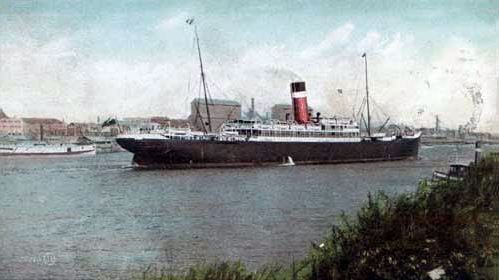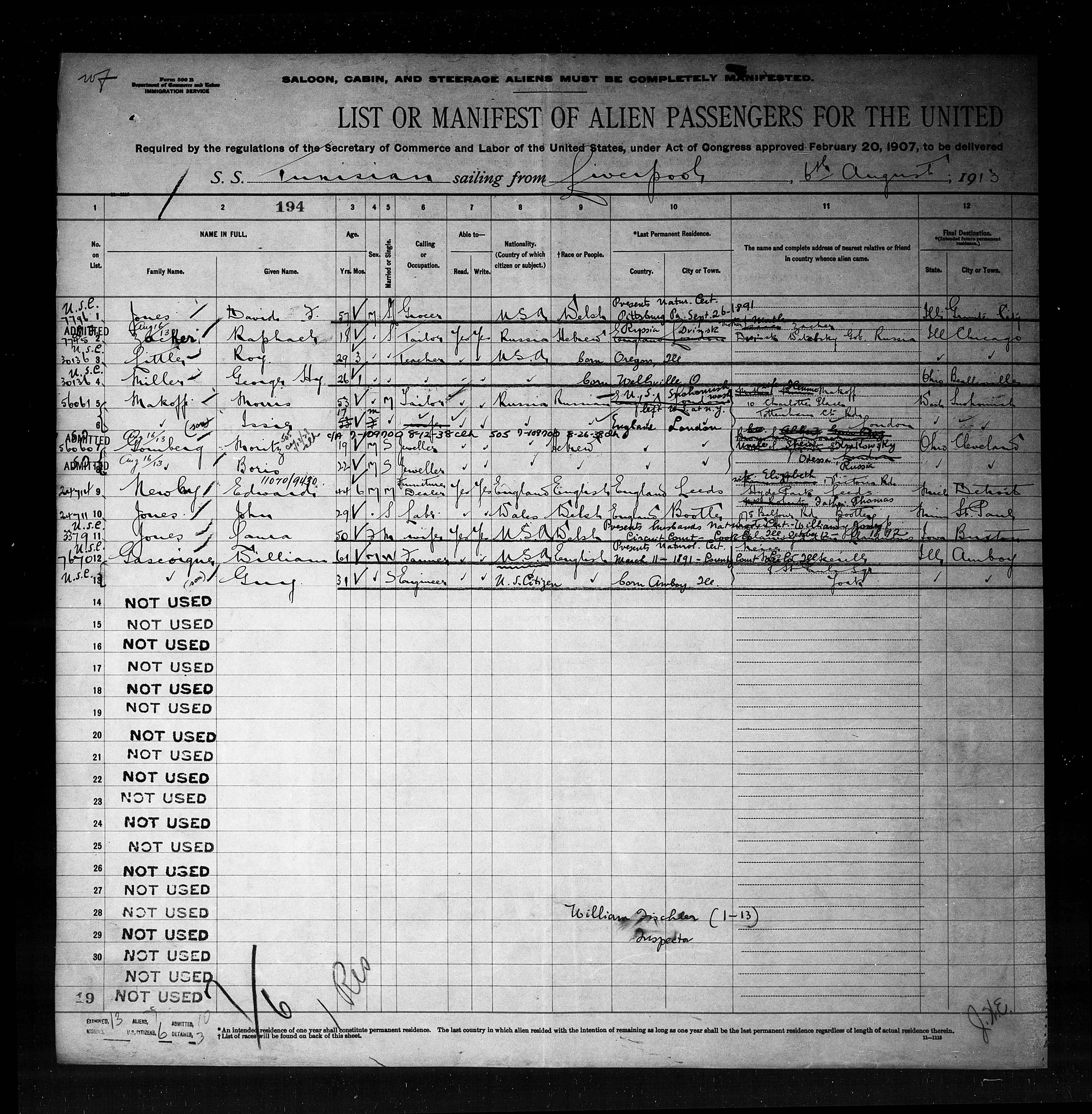
The S.S. Tunisian (Allan Line) leaving Montreal (1906) (From a postcard)
On the 6th of August, 1913, Moritz Gomberg, aged 19, sailed for North America on the S.S. Tunisian, which departed from Liverpool, England. He declared Russia as the country of his birth, and his race as “Hebrew”. (Which may help to explain “Hebrewland” on the map he would publish in 1942, nearly thirty years later.) An uncle in Odessa, Sheia Krakowsky, is identified as Moritz Gomberg’s nearest living relative or friend in Russia.
Moritz Gomberg’s last place of permanent residence before he emigrated to America, was London, England. Gomberg was unmarried, a jeweller by trade, intending to reside in Cleveland, Ohio.
Moritz was accompanied on the voyage by Boris Gomberg, aged 22, also a jeweller and unmarried, bound for the same destination, declaring the same country of origin, the same race, and the same Russian uncle. The rubber-stamp “ADMITTED” appears over the “Number on List” of each of the two Gomberg passengers to America on the “Manifest of Alien Passengers for the United States” aboard the S.S. Tunisian.
First Manifest Record

Vermont, St. Albans Canadian Border Crossings, 1895-1954
record-image_3QS7-L9DS-C3V
Source: “Vermont, St. Albans Canadian Border Crossings, 1895-1954,” database with images, FamilySearch (https://familysearch.org/ark:/61903/1:1:QK3B-WQYR : accessed 26 April 2016), Boris Gomberg, 1913; citing M1464, Soundex Index to Canadian Border Entries through the St. Albans, Vermont, District, 1895-1924, 224, NARA microfilm publications M1461, M1463, M1464, and M1465 (Washington D.C.: National Archives and Records Administration, publication year); FHL microfilm 1,561,310.
How do we know this is Maurice Gomberg
of Map fame?
We know from author Douglas Reed in 1967 (The Battle for Rhodesia) and again in 1951 (Far and Wide) that Maurice Gomberg’s real given name is Moritz. The Constitutionalist of March, 1944 confirms it. Therefore, we need to look for Moritz in the passenger manifests, not Maurice. When Gomberg is naturalized in 1926, he will officially call himself Maurice.
In The Battle for Rhodesia, Douglas Reed recounts:
“… Mr. Moritz Gomberg was presumably unknown to the multitudes embroiled when in 1942 he popped up with a “Group for a New World Order” and published a map showing the rearrangement of the globe. He foresaw that at the war’s end the communist empire would extend from the Pacific to the Rhine (Berlin is not far from the Rhine), that a Hebrew State should be set up in Palestine (which happened), that the remnant of Western Europe should disappear in a “United States of Europe” (something which is now being actively pursued), and that the African continent should become a “Union of Republics” (it is becoming a shambles, the same thing).”
In Far and Wide, 1951, Reed says:
“What real purpose did Mr. Roosevelt promote through the way he used his imperial powers? He furthered the main principles of a plan for the redistribution of the earth published in 1942 (but clearly prepared much earlier) by a mysterious ‘Group for a New World Order‘, headed by a Mr. Moritz Gomberg. What this group proposed was startling at the time but proved farsighted. The main recommendations were that the Communist Empire should be extended from the Pacific to the Rhine, with China, Korea, Indo-China, Siam and Malaya in its orbit; and that a Hebrew State should be set up on the soil of ‘Palestine, Transjordan and the adjoining territories’. These two projects were largely realized. Canada and numerous ‘strategic islands’ were to pass to the United States. …”.
Thus, Douglas Reed, writing in 1951, clearly associates “Moritz” Gomberg with the plan of the Map.
The Constitutionalist of March 3rd, 1944, in Volume 15, Number 3, confirms the dual first name of the author of the now-famous “POST-WAR NEW WORLD ORDER MAP”, published in Philadelphia.
Says The Constitutionalist: “Maurice” is American for “Moritz”.
As far as we know, Mr. Gomberg only made one map, which does not qualify him as a professional cartographer.
In fact, Maurice Gomberg has been called a lawyer, a clock maker, a watch maker, a cartographer and a printer by various persons interested in his origins.
However, in an article written in Polish by Professor Aleksander Gella, entitled “Mapa Gomberga”, published in London, England in 1985 in a Polish journal edited by Gella for his own Veritas Foundation Publications, Professor Gella interviews former acquaintances of “Maurice” Gomberg, the author of the map. London, England, was Moritz Gomberg’s last place of permanent residence before he embarked for Liverpool to board the SS. Tunisian.
Gella conveys the recollections of some of Maurice Gomberg’s contemporaries, that Gomberg was originally a clock-maker, or a watch-maker, who sympathized with, but was not a member of, the Communist Party of America.
The title of the journal in which Gella’s information was published, translates to (“Polish Affairs in the World Perspective”). The original Polish is: “Sprawy polskie w perspektywie światowej”.
The passengers manifest of the S.S. Tunisian in 1913 describes Moritz Gomberg as a jeweller by profession. Gella’s informants call Maurice a “watch-maker”. But, a “watch-maker” is a jeweller.
In addition, there are naturalization records in Pennsylvania for a Maurice Gomberg who originates in Russia, and whose occupation is given as that of a “watch maker”. The date of birth on these records matches 1894, the year given on the passenger manifests of 1913 when Moritz Gomberg, the jeweller, set sail for North America.
As to the claim of the Shreveport, Los Angeles “Councillor” newspaper of 22nd October 1965 that Maurice Gomberg was a Philadelphia lawyer, the Philadelphia Bench and Bar for 1945, contains no word of any lawyer called Gomberg.